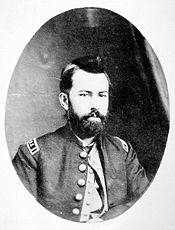Edward Palmer (botanist)
| Edward Palmer | |
|---|---|

Kansas City, 1864
|
|
| Born |
January 12, 1829 England |
| Died | April 10, 1911 (aged 82) United States |
| Nationality | English |
| Fields | Botany / Archaeology |
| Institutions | U.S. Department of Agriculture |
Edward Palmer (1829–1911) was a self-taught British botanist and early American archaeologist.
Born on 12 January 1829 and baptised on 22 February 1829 at Brandon, Suffolk, England, the son of Robert and Mary Palmer, he emigrated to the United States in 1850 where he initially settled in Cleveland, Ohio. He travelled to South America and became a medical doctor, serving with the Union Army during the American Civil War.
Palmer collected natural specimens, primarily plants, for the Smithsonian Institution and the U.S. Department of Agriculture, among other institutions. According to his biographer,
“The collections made by Edward Palmer between 1853 and 1910 were prepared with more care than those of most of his contemporaries. He was primarily a botanical collector, and his botanical specimens were exceptionally well documented for his time.... [However,] he was unwilling to attend to the documentation and distribution of his own collections, and preferred to entrust them for naming, sorting and selling, to his friends and patrons—prominent scientists all.”
He collected specimens in the southwestern United States, Florida, Mexico (including Baja California), and South America and had about 200 species and two genera (Palmerella and Malperia) of plants named after him. The standard botanical author abbreviation Palmer is applied to species he described.
Palmer’s botanical collections (numbering over 100,000) are mostly pressed and dried and reside at research institutions around the world. These institutions include the Smithsonian Institution, Harvard University, the Missouri Botanical Garden, the New York Botanical Garden, Royal Botanic Garden Kew, the British Museum, and many others. The Palmer botanical collection in the U.S. National Herbarium at the Smithsonian Institution remains the largest, containing over 16,000 specimens collected over sixty years.
...
Wikipedia
